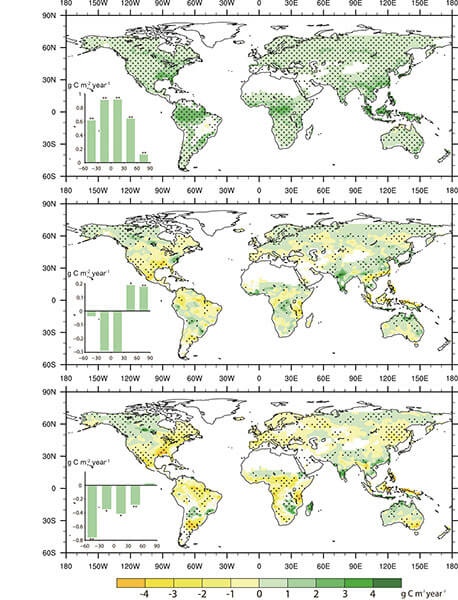March 7, 2017
Rising CO2 due to climate change may not improve agriculture, model shows
 Modeling the effects of increased CO2 on global crop production at Purdue University shows that because of the complex effects and feedback behaviors that connect plant life and the atmosphere, many areas may suffer due to increased heat and reduced rainfall, despite the increase in the plant nutrient. (Purdue University graphic by Qianlai Zhuang)
Download image
Modeling the effects of increased CO2 on global crop production at Purdue University shows that because of the complex effects and feedback behaviors that connect plant life and the atmosphere, many areas may suffer due to increased heat and reduced rainfall, despite the increase in the plant nutrient. (Purdue University graphic by Qianlai Zhuang)
Download image
WEST LAFAYETTE, Ind. — Although many people have argued that rising carbon dioxide levels would benefit crop production, a recent model of the effects of increased CO2 shows that it's not that simple and that elevated levels could have a much less positive effect on plant photosynthesis than previously predicted.
Purdue University researchers tested the effects of increased CO2 and warmer temperatures on plant water use. Although increased carbon dioxide and warmer temperatures generally improve photosynthesis, in these experiments the researchers found that pores on plant leaves, known as the stomata, were predicted to narrow in these conditions, reducing the amount of moisture plants release into the air.
Although this change may mean some plants are more efficient in their water use in some arid regions, overall this change in plant physiology will have its own climate effects, resulting in less rainfall in some regions, damaging plants and crop yields, says Qianlai Zhuang, professor of earth and atmospheric science.
"This study reveals that while increasing atmospheric carbon dioxide can directly strengthen plant uptake of CO2, it can also reduce plant transpiration, influence global precipitation patterns, and increase warming locally," he says.
The research was published in a recent issue of Geophysical Research Letters. Zhuang's graduate student Zhu is the lead author on the paper.
Lisa Welp, assistant professor of biogeochemistry in Purdue's Department of Earth, Atmospheric, and Planetary Sciences, and a co-author on the paper, says that in many terrestrial ecosystems, precipitation is from water recycled to the atmosphere by plants upwind, affecting both precipitation and temperatures.
"The role that terrestrial vegetation plays in rainfall recycling on land is often simplified or overlooked, but it's a key player in determining regional precipitation patterns and, therefore, productivity in water-limited ecosystems," Welp says. "If some plants reduce their transfer of water to the atmosphere by reducing transpiration rates, this results in regional declines in precipitation. It also results in local heating because evaporating water from plant leaves acts like an air conditioner, keeping surface temperatures cooler."
Overall, the effect is strong enough that there is no net increase in global agricultural production, Zhuang says. In fact, as carbon dioxide increases globally, the modeling showed that plant life in most regions of the world suffers considerably due to rising temperatures and decreased precipitation.
"You cannot look at just one effect in isolation, such as photosynthesis, and make a determination of how it will affect global crop production," Zhuang says. "There are both direct and indirect effects, and both should be considered."
Atmospheric carbon dioxide has increased from 280 parts per million before the Industrial Age, which began in the late 1700s, to the current level above 400 parts per million.
Zhuang and graduate student Peng Zhu devised six model experiments using historic climate data from 1850 to 2011. They found that although a few areas would see improved plant growth - including parts of Canada, most of Madagascar, and the southern tip of India - other regions on the planet would suffer.
"This study indicates that the net CO2 fertilization effect will be overestimated unless vegetation-climate feedback effects are taken into account," Zhu says.
This research was funded by the National Science Foundation (award number 1028291) and NASA (award NNX14AD91G).
Writer: Steve Tally, 765-494-9809, steve@purdue.edu, @sciencewriter
Sources: Qianlai Zhuang, 765-494-9610, qzhuang@purdue.edu
Peng Zhu, zhu467@purdue.edu
Lisa Welp, lwelp@purdue.edu
ABSTRACT
"Elevated atmospheric CO2 negatively impacts photosynthesis through radiative forcing and physiology-mediated climate feedback"
Peng Zhu , Qianlai Zhuang, and Lisa Welp, Purdue University, West Lafayette, Ind., USA; Philippe Ciais, Laboratoire des Sciences du Climat et de l'Environment, France; Wenyu Li, Tsinghua University, Beijing, China; Qinchuan Xin, Sun Yat-Sen University, Guangzhou, China
Increasing atmospheric CO2 affects photosynthesis involving directly increasing leaf carboxylation rates, stomatal closure, and climatic effects. The direct effects are generally thought to be positive leading to increased photosynthesis, while its climatic effects can be regionally positive or negative. These effects are usually considered to be independent from each other, but they are in fact coupled through interactions between land surface exchanges of gases and heat and the physical climate system. In particular, stomatal closure reduces evapotranspiration and increases sensible heat emissions from ecosystems, leading to decreased atmospheric moisture and precipitation and local warming. We use a coupled earth system model to attribute the influence of the increase in CO2 on gross primary productivity (GPP) during the period of 1930–2011. In our model, CO2radiative effects cause climate change that has only a negligible effect on global GPP (a reduction of 0.9 ± 2% during the last 80 years) because of opposite responses between tropical and northern biomes. On the other hand, CO2 physiological effects on GPP are both positive, by increased carboxylation rates and water use efficiency (7.1 ± 0.48% increase), and negative, by vegetation-climate feedback reducing precipitation, as a consequence of decreased transpiration and increased sensible heat in areas without water limitation (2.7 ± 1.76% reduction).When considering the coupled atmosphere-vegetation system, negative climate feedback on photosynthesis and plant growth due to the current level of CO2 opposes 29–38% of the gains from direct fertilization effects.

